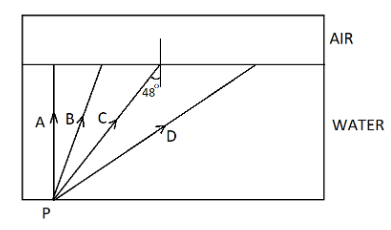
The diagram shows a point source P inside a water container. Four rays $A,B,C,D$ starting from the source $P$ are shown up to the water surface.
$\left( i \right)$ Show in the diagram the path of these rays after striking the water surface. The critical angle for water air surface is ${48^ \circ }$ .
$\left( {ii} \right)$ Name the phenomenon which the rays $B$ and $D$ exhibit.


Answer
442.8k+ views
Hint:The above problem can be solved by using the concept of reflection and refraction of the light ray. This phenomenon depends on the medium. The critical angle is the angle at which the light ray is completely reflected back at the boundary of the medium and comes back in the incident medium. This backing of incident light in the incident medium is called the total internal reflection. It occurs when the incident angle exceeds the critical angle.
Complete step by step answer:
So in this question, the value given for the critical angle at the water-air surface is ${\theta _C} = {48^ \circ }$ .
$\left( i \right)$ The refraction or reflection of a light ray at the boundary of two media depends on the critical angle of the boundary surface. The light ray gets refracted if the incident angle becomes less than the critical angle. The light ray gets reflected if the incident angle becomes greater than the critical angle. The reflection and refraction are shown in the below diagram:

Thus, the light rays $A$ and $B$ refracted, and light rays $C$ and $D$ reflected from the air-water surface.
$\left( {ii} \right)$ The incident angle of the light ray $B$ is less than the critical angle, so the light rays $A$ and $B$ refracted at the air-water surface. The incident angle of the light ray $D$ is greater than the critical angle, so the light ray $D$ gets internally reflected in the water. Thus, the light $B$ undergoes refraction and the light ray $D$ undergoes total internal reflection.
Therefore, the total internal reflection is the phenomenon in which the rays $B$ and $D$ exhibit.
Note:So we have seen the total internal reflection and its condition. Therefore to clear it much better we should know the difference between reflection and refraction. So when a ray strikes the medium on the plane then the reflection will occur whereas when the light ray bends while passing through the medium then we will call it refraction. And this is the main difference between these two.
Complete step by step answer:
So in this question, the value given for the critical angle at the water-air surface is ${\theta _C} = {48^ \circ }$ .
$\left( i \right)$ The refraction or reflection of a light ray at the boundary of two media depends on the critical angle of the boundary surface. The light ray gets refracted if the incident angle becomes less than the critical angle. The light ray gets reflected if the incident angle becomes greater than the critical angle. The reflection and refraction are shown in the below diagram:

Thus, the light rays $A$ and $B$ refracted, and light rays $C$ and $D$ reflected from the air-water surface.
$\left( {ii} \right)$ The incident angle of the light ray $B$ is less than the critical angle, so the light rays $A$ and $B$ refracted at the air-water surface. The incident angle of the light ray $D$ is greater than the critical angle, so the light ray $D$ gets internally reflected in the water. Thus, the light $B$ undergoes refraction and the light ray $D$ undergoes total internal reflection.
Therefore, the total internal reflection is the phenomenon in which the rays $B$ and $D$ exhibit.
Note:So we have seen the total internal reflection and its condition. Therefore to clear it much better we should know the difference between reflection and refraction. So when a ray strikes the medium on the plane then the reflection will occur whereas when the light ray bends while passing through the medium then we will call it refraction. And this is the main difference between these two.
Recently Updated Pages
Master Class 12 Economics: Engaging Questions & Answers for Success

Master Class 12 Maths: Engaging Questions & Answers for Success

Master Class 12 Biology: Engaging Questions & Answers for Success

Master Class 12 Physics: Engaging Questions & Answers for Success

Master Class 12 Business Studies: Engaging Questions & Answers for Success

Master Class 12 English: Engaging Questions & Answers for Success

Trending doubts
Which are the Top 10 Largest Countries of the World?

Differentiate between homogeneous and heterogeneous class 12 chemistry CBSE

Draw a labelled sketch of the human eye class 12 physics CBSE

What is the Full Form of PVC, PET, HDPE, LDPE, PP and PS ?

What is a transformer Explain the principle construction class 12 physics CBSE

What are the major means of transport Explain each class 12 social science CBSE




